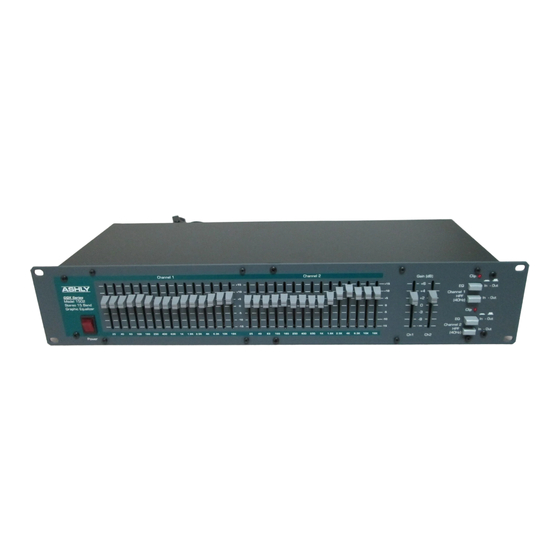Table of Contents
Advertisement
GQX Series
Model 3102
Stereo Third Octave
Graphic Equalizer
20
25
31.5
40
50
63
80
100
On
Off
Power
GQX Series
Model 3101
Third Octave
Graphic Equalizer
20
25
31.5
40
50
63
80
100
Power
Channel 1
GQX Series
Model 1502
Stereo 15 Band
Graphic Equalizer
25
40
63
100
180
250
400
630
Power
847 Holt Road
Toll-Free: (800) 828-6308 Fax: (716) 872-0739 Internet: http://www.ashly.com/
GQX-3102
GQX-3101
GQX-1502
Graphic Equalizer
Operating Manual
125
160
200
250
315
400
500
630
800
1K
1.25K 1.6K
2K
2.5K 3.15K
125
160
200
250
315
400
500
630
800
1K
1.25K 1.6K
2K
2.5K 3.15K
+15
+10
+5
0
-5
-10
-15
1K
1.8K
2.5K
4K
6.3K
10K
18K
25
40
63
100
180
250
ASHLY AUDIO INC.
Webster, NY
14580-9103 Phone: (716) 872-0010
Channel 1
+6
+15 (+6)
+6
+3
+4
+10
+2
+5
0
0
-5
-3
-12
-15
-10
-9
-18
-
-21
-15 (-6)
Gain (dB)
4K
5K
6.3K
8K
10K 12.5K 16K
20K
+6
+15 (+6)
+6
+3
+4
+10
+2
+5
0
0
-3
-5
-12
-15
-9
-10
-18
-
-15 (-6)
-21
Channel 2
+15(+6)
+6
+6
+3
+4
+10
+2
+5
0
0
-3
-5
-12
-15
-9
-10
-18
-
-15(-6)
-21
4K
5K
6.3K
8K
10K 12.5K 16K
20K
Gain
(dB)
Channel 2
Gain (dB)
+6
+15
+10
+4
+5
+2
0
0
-5
-3
-9
-10
-
-15
400
630
1K
1.8K
2.5K
4K
6.3K
10K
18K
Ch1
Clip
VU
Range
6 - 15
0
-3
EQ
In - Out
-6
-9
HPF
In - Out
50
100
25
200
Output
12
285
Level
(Hz)
VU
Clip
Range
6 - 15
0
-3
EQ
In - Out
-6
-9
HPF
In - Out
50
100
25
200
12
285
(Hz)
Clip
VU
Range
6 - 15
0
EQ
In - Out
-3
-6
-9
HPF
In - Out
50
100
25
200
Output
Level
12
285
(Hz)
Clip
EQ
In - Out
Channel 1
HPF
In - Out
(40Hz)
Clip
EQ
In - Out
Channel 2
In - Out
HPF
(40Hz)
Ch2
Advertisement
Table of Contents

Summarization of Contents
Audio Connectivity and Cables
Input Connector Types
Details on 1/4 inch stereo phone jacks, XLR connectors, and terminal strips for input signals.
Servo-Balanced Output Explained
Explanation of the active servo-balanced output stage and its advantages over conventional outputs.
AC Power Requirements and Safety
Grounding and Ground Loop Prevention
Information on terminal strip grounds, chassis ground, and jumper strap for preventing ground loops.
Control Panel Features
Gain Control Operation
Description of the gain control's function, range, and use in level compensation.
High-Pass Filter Functionality
Explanation of the high-pass filter's role in removing low-frequency interference and its frequency adjustment.
Equalization Faders
Details on how individual faders adjust gain/loss at specific frequencies for equalization.
EQ Bypass Switch
How the EQ bypass switch allows comparison of equalized vs. flat response.
Range Switch Selection
Explanation of the range switch for selecting ±15dB or ±6dB equalization settings.
Level Meters and Indicators
Description of the 10-segment LED level meters and the clip indicator LED.
Typical Applications of Graphic Equalizers
General Tone Control
Using the equalizer for intuitive tone shaping and translating desired sound into frequency adjustments.
Feedback Control Techniques
Methods for using the equalizer to control moderate feedback issues and potential pitfalls.
Console Channel Equalization
Patching the equalizer into console channel inserts for detailed sound tailoring.
Large Room Equalization
Techniques for equalizing large rooms to improve clarity and reduce muddiness.
Troubleshooting Common Issues
Troubleshooting: No Audio Output
Steps to diagnose and resolve issues related to no audio output from the unit.
Troubleshooting: EQ Controls Ineffective
Steps to take when the EQ controls appear unresponsive or have no audible effect.
Troubleshooting: Peak Light Indicators
Interpreting and resolving issues indicated by the peak light flashing or staying on.
Troubleshooting: Distorted Sound
Identifying causes of distorted sound and the role of the clip LED.
Troubleshooting: Hum and Noise
Common causes of hum and noise and methods for elimination.
















Need help?
Do you have a question about the GQX-3101 and is the answer not in the manual?
Questions and answers